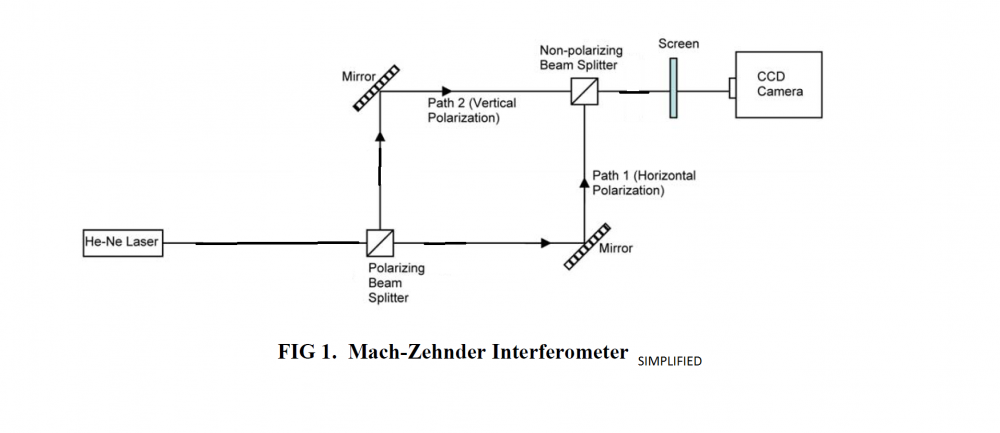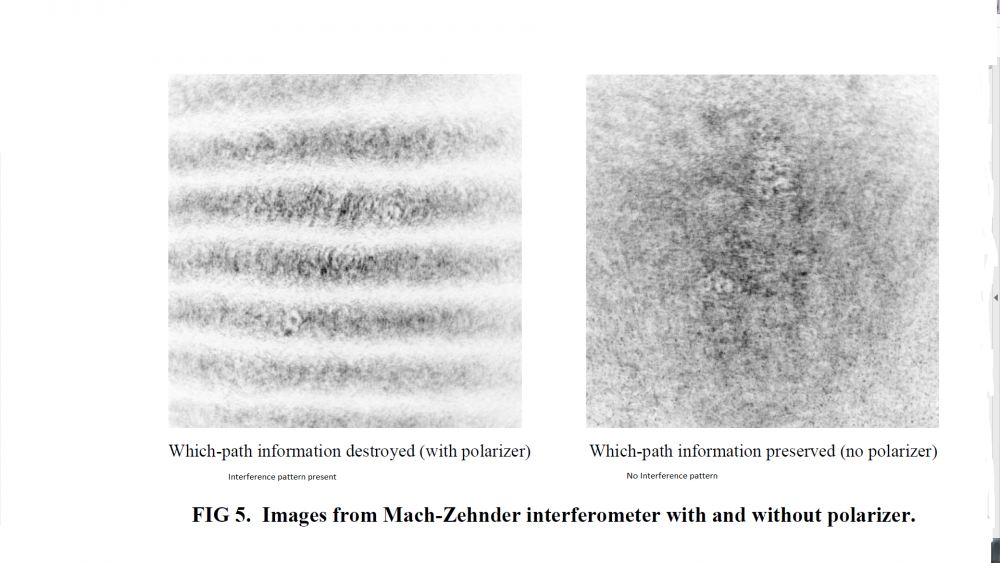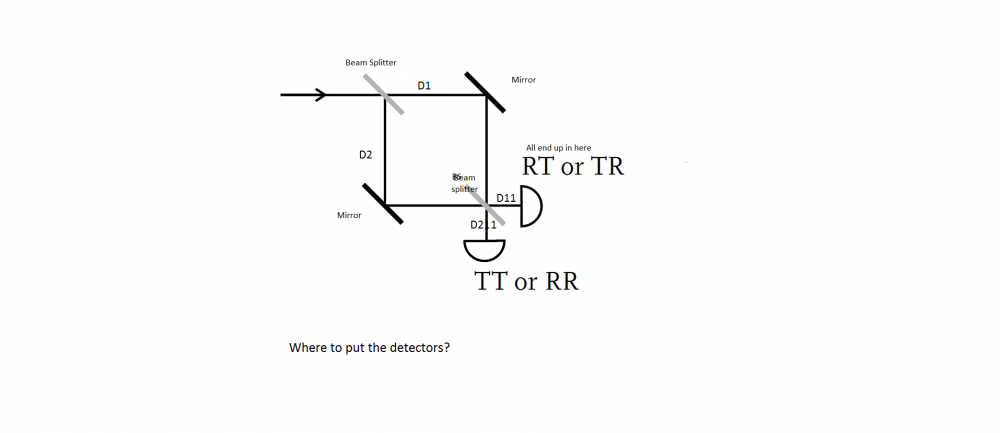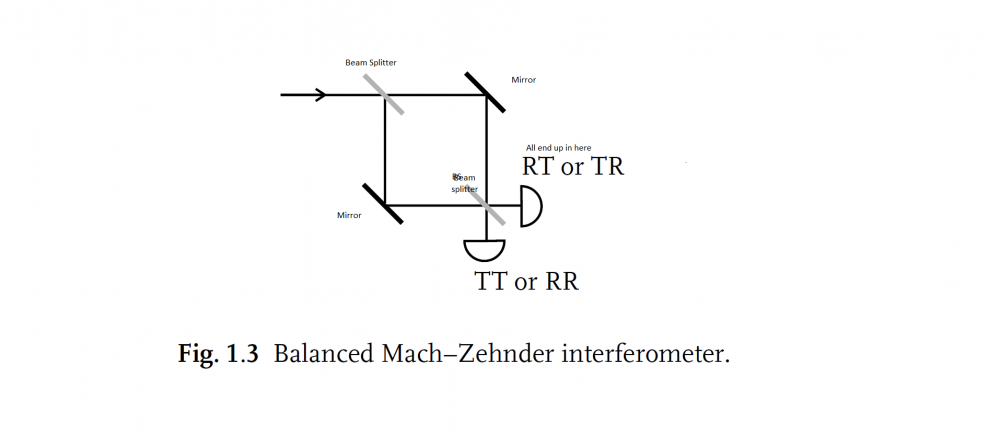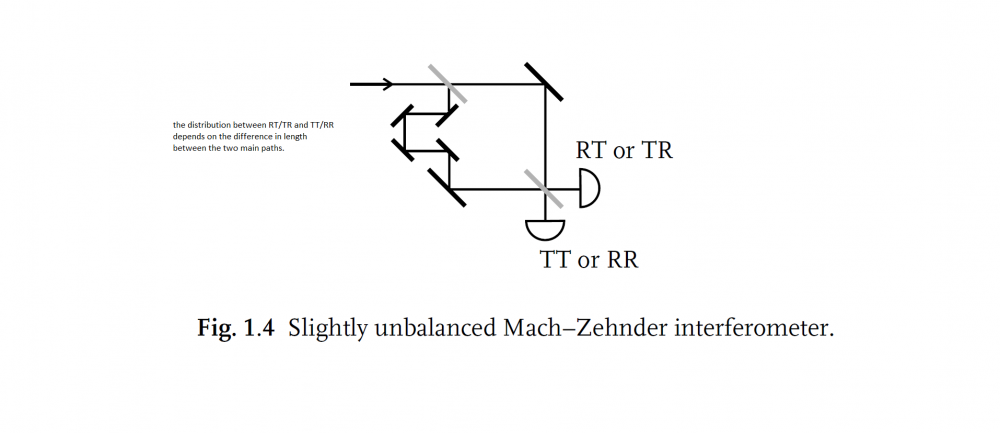

Dalo
Senior Members-
Posts
413 -
Joined
-
Last visited
Content Type
Profiles
Forums
Events
Everything posted by Dalo
-
The reference provided by @swansont is much more challenging. I will therefore first present their specific version of MZI, and try to simplify it without betraying their intentions. The first original drawing is therefore quite cluttered, as all elements used at one time or another seem to have been given a place at the same time. I have taken the liberty of taking out all the elements that are not part of a simple MZI. The last image, for now, is the end result. As you see, this is much more complicated than what Scarani had presented. ****************************************** Well, I will be very grateful to you if you could give me a reference where this issue, the disappearance of interference patterns, is treated with wave theory. I am especially interested in how low intensity is treated exclusively with wave theory. I am simply using the examples given by people more knowledgeable than me. Scarani is abundantly clear, citing Feynman (volume 3 of the Lectures on Physics, which I happen to also have read), as are the (students) authors Swansont suggested. I cannot upload the pdf file because of size limitation. It will have to wait for the following post.
-
I don't consider them as being the same thing. ********************************************** Look at Fig. 1.3. Where would we place detectors to determine the path each particle has taken? Well, without even looking at the detectors, we know that we will be unable to determine the path taken to RT or TR, just as we have no way of knowing if the photon would have hit TT or RR. Fig. 1.3 is therefore inherently ambiguous. This gives us a possible explanation of why when we use a detector, say D1, we get a 50-50 distribution instead of the 100% of Fig.1.3. D1 cannot exclude the path D2 since a photon could simply end up in RT or TR, explaining why we get the 100%. In fact wherever we put our detector, there will always be a possible distribution of 0-100% The only way to exclude any ambiguity would be to use something like My Interferometer. A single detector, or even all of them at the same time, would therefore destroy the alleged interference, without creating a mystery. After all, we still have Fig.1.4 and the effects of the factor length. Even though we have no idea how it works.
-
I remember drawings of electronic gates, so I see how the confusion could have started.
-
This thread has nothing to do with electronic gates. At least, as far as my own intentions are concerned.
-
I have no idea what you are talking about. We are dealing here with interferometers, not with gates, and until now all I have done is present drawings of the different possibilities as recognized by all authors. If you want to present your own theory, then you are welcome to do so. I will wait until you are finished to give any comment if necessary, and then resume my own argumentation. Unless it will turn out to be completely superfluous.
-
I have tinkered somewhat with one of the drawings to get this one. It would have been much worse if I had to draw it entirely by hand! This is simply to make a point: we decide how ambiguous our experiments are. In this drawing it will be clear each time where the particle went. Of course, this cannot be considered as a valid argument since it simply destroys the interference. It must therefore rather be understood as a general comment on how experiments are set up that claim to arrive at wondrous conclusions. ************************************* I don't understand the objective of this remark. When we use a MZI, we are dealing with photons as particles.
-
Please allow me to present my arguments first. Also, when dealing with interferometers light is considered exclusively as a particle.
-
This is a spin-off of my thread "Double slit experiments and superposition". In that thread I had limited myself to that kind of experiment to argue that the so-called superpositon of particles was more a theoretical assumption/conclusion than an empirical fact. People reproached me to limit the discussion artificially and ignore interferometers, especially the Mach-Zehnder interferometer that is considered by many authors as the logical and practical equivalent of the double slit experiment. I will take this equivalence for granted, even though I think it is much more complicated than that. Still, I cannot deny that the same questions can be asked in both experiments, in particular, the path a particle has taken, and maybe even more importantly, whether observation makes the particles change their path and destroy the ambiguity of the path taken, an effect called interference to emphasize the analogy with the wave phenomenon. A very nice introduction to The Michelson interferometer can be found here. This thread will mostly deal with the Mach-Zehnder Interferometer or MZI. The following drawings, with some minor comments from my part, have been taken from Quantum physics : a first encounter: interference, entanglement and reality By Valerio Scarani, 2006. The first drawing shows the principle of a beam splitter which allows 50% of the beam to be transmitted (T) and the other 50% to be Reflected (R). The second picture is a little bit more complicated, but the result is not surprising: 25% of the photons into each detector. We come to our main course, the MZI, which brings us our big surprise. Instead of the expected distribution of 50-50 between RT/TR and RR/TT, all the photons end up on one side, in this case in RT/TR. The last image is a variation on the previous one, with extra mirrors to change the length of one path. The result is also very astonishing. The distribution between both groups seems to depend on the difference between the two main paths. The interpretations given to this phenomenon ignore completely this factor length and concentrate on the "knowledge" that particles seem to have of the different possible paths, and their ability to adapt their behavior accordingly. My claim will be: there is no superposition and the particles never change their behavior. I advise the reader to print the different drawings to more easily refer to them.
-
I have been given another warning, and I have no idea why. I will not change for the reasons given. If you think that it is the wrong attitude, maybe you should tell me so, and I will stop my membership of this forum. You do not need to ban me, I will simply leave.
-
This is a philosophical claim. Physics won't help you defend it.
-
That is not true. The last thing you need as a philosopher is to get lost in technical details only specialists can understand.
-
I never used not being a physicist as an excuse. There is a difference between a technical discussion of Physics issues that only physicists can have and follow, and issues that concern physics to which non-physicists as myself can contribute. As I said, I am a philosopher. I cannot change that and pretend I am learning to be a physicist. That is just not the case. I approach issues in Physics from a philosophical state of mind. For that, I need a minimum of knowledge to know, at in least in broad strokes, what I am talking about. If you think that philosophers, people in general, need to be experts in Physics before they can participate in this forum, then just say so and I will cease all my contributions.
-
It is not the only one I accept as evidence. It is the only one I feel confident enough to talk about and make a claim about. edit: I will, sooner than later, deal with the matter of interferometers, and how they relate to the claim I have made about double slit experiments. When I am ready.
-
nope. I do love science fiction and Fantasy though. But that is just for fun!
-
In this case we won't discuss it exhaustively, but it might be interesting to know what it is.
-
I have done so because I cannot claim what I am not certain about. As far as actual physics is concerned I am pointing at what I consider to be something that needs attention. That certainly does not mean that I am refusing physics. *********************************** I am afraid I am not sure how to reply to your question. The issue as I understand it is whether "observing" particles destroys the interference patterns. That "observing" does not really mean "human observing", since we are talking about microscopic particles we cannot see with our naked eye. It is usually in the form of detectors, and they come in all kinds of shapes and colors, that can tell us through which the particles went. The human brain therefore is not really needed since the whole experiment could be automatized. Some understand that as "potential" human observation. A very complicated question, if you ask me.
-
I have narrowed the range of my claim. That is I think my good right.
-
No, I did not claim it because it is not a matter of interference. The point is the apparent disappearance of interference patterns as discussed in the context of double slit experiments. Maybe it is applicable to interferometers. Maybe not. I would not dare defend either position without further research.
-
?
-
I am very much interested in details that I need to understand the principles involved. That does not mean that I need to know everything a physicist knows about the subject I am discussing. There is a difference between an expert who needs to know as much as possible to perform experiments or build "things", and the amount of information an outsider needs to be able to speak about a process. The same way, a good mechanic should be able to drive a car, but he does not need to become a race pilot. And vice versa. Concerning the difference between interferometers and double slits, it is a complicated issue that certainly deserves more time than the few remarks I have allocated to it. What I did was in my opinion the only honest position I could take, and that is to propose to treat of this subject in its own thread. Whatever the conclusion might be of this thread, I think it is my right to limit the range of my claim and to expect from others not to widen the subject unnecessarily. I have not in any way claimed that what I say of double slit experiments is applicable to interferometers, so why would you demand from me that I defend such a claim? ******************************************** No, and I am really not interested in diagrams or drawings that can be made to say or prove anything one wants. That is why I speak each time of empirical evidence and "real" or "live" experiments.
-
In an interferometer a beam is split in two. Otherwise it would not work. In a double slit, the question whether the particle splits in two is the central issue that needs to be resolved. The case of the vapor chamber, if that is what you mean, turned out to be a thought experiment. I had used it as if it were a real experiment. I have never performed such an experiment and wouldn't know how to set it up. I am dependent on the information I get from the books and articles I read, or from video clips I watch on Youtube.
-
Yes, you are right on this point. I am afraid that is not enough and you will have to be more specific. I do not know what you mean by proof or evidence because apparently what I have presented does not satisfy you.
-
Maybe if you could tell me what I need to prove, I would then try to do it. But it is not enough just to say it and expect an answer. I honestly have no idea what is expected of me.
-
I understand your confusion. maybe this will help


